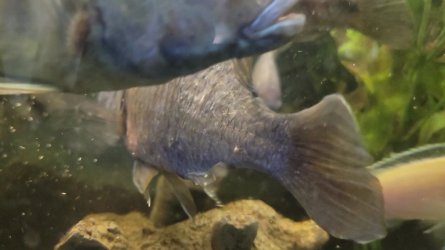I was watching my cichlids 2 days ago and noticed on 2 of them there were these red lesion type things. Same spot on the body, just opposite sides. I had posted when I first took in this tank about a different cichlid that had the same lesion looking thing on it's side. It would twitch a bit every now and then too and kinda just stay in the same spot, almost staring at me lol. But I had that fish uthanized along with another one that seemed to be suffering I thought at that time. I was told it just looked like an old fish, but now these two, awhile later, are showing kinda that same thing. The blue one is looking worse, as it was just a red dot, now a patch on the other side by his fin and 2 lesion things. I attached files.
If anyone has any ideas, please share!!!!! Thank you!!
If anyone has any ideas, please share!!!!! Thank you!!
Attachments
-
 VideoCapture_20220515-185533.jpg123.1 KB · Views: 39
VideoCapture_20220515-185533.jpg123.1 KB · Views: 39 -
 VideoCapture_20220515-185627.jpg172.7 KB · Views: 42
VideoCapture_20220515-185627.jpg172.7 KB · Views: 42 -
 VideoCapture_20220515-185840.jpg140.4 KB · Views: 41
VideoCapture_20220515-185840.jpg140.4 KB · Views: 41 -
 VideoCapture_20220515-185946.jpg117.5 KB · Views: 36
VideoCapture_20220515-185946.jpg117.5 KB · Views: 36 -
 VideoCapture_20220515-185955.jpg137.5 KB · Views: 37
VideoCapture_20220515-185955.jpg137.5 KB · Views: 37 -
 VideoCapture_20220515-190022.jpg131.6 KB · Views: 35
VideoCapture_20220515-190022.jpg131.6 KB · Views: 35 -
 20220515_184450.jpg287.8 KB · Views: 40
20220515_184450.jpg287.8 KB · Views: 40 -
 20220515_184332.jpg285.3 KB · Views: 34
20220515_184332.jpg285.3 KB · Views: 34 -
 20220515_184027.jpg176 KB · Views: 55
20220515_184027.jpg176 KB · Views: 55

